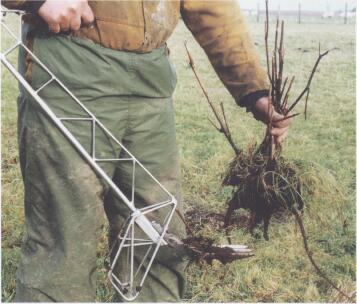Philip Trevelyan and Dr. John Zarb
Article taken from Conservation and Land Management - Volume 2, Number 4 - Winter 2004
Return to Publications Page | Page 1 | Page 2 | Page 3 | Page 4 |
| Conservation site case studies |
| A
wild flower meadow managed under the Countryside Stewardship scheme
at Menethorpe, North Yorkshire, contained spear thistle, dock
and ragwort at densities of around ten weeds per 25m2. It was
treated in one pass by a team at a cost of £44 per ha. The
work took one day in April. Under the management scheme, the landowner
had the option of spot-spraying individual weeds. However, the
approach taken was:
1)
considerably less expensive than the chemical option; Ten-year
old docks at densities of up to 15 plants per 25m2 were removed
from 3ha of municipal parkland at a cost of £370 per ha
in December 2000. The land had been densely infested with mature
docks, some standing 1.5m tall. Removal of the large root clusters
from the stony soil often took significant effort, and there
were concerns of both spreading seed and of breaking roots.
There was no immediate follow-up to this work, and rangers on
this community forest park were slow to clear |
practice
problems could be drastically
reduced by tackling them early,
during winter and spring, when
the ground is moist. Weed
control should be regarded as an
ongoing, long-term process. The
four main weeds dealt with are
docks, spear thistle, ragwort and
creeping thistle.
Dock clearance
work has been
started in February and March,
leaving follow-up until May, but
sites have also been cleared the
week before Christmas. Being
thistle
March/April or September/
October, and these are the best
times to remove them. Seed can
be wind borne or be present in
the soil seed bank. Germination
and growth are encouraged by
extended summer or winter
grazing, especially by sheep. In
an April trial 8,016 seedlings
were removed from 5ha, at a cost
of £130. Ragwort rosettes were
removed in the same operation.
The cause of this weed problem
was a combination of wind-
blown seed from a site 70m
away, compounded by enforced
chopped out by a four-man gang.
support, the integrated use of
other techniques, and many
other factors. RIP weeding is no
exception.
infestation, for example, manual
labour simply becomes too time-
consuming to be cost-effective.
Here, pasture topping and
mowing may be more
appropriate. Some jobs can be
daunting: the removal of small
docks from overgrazed pasture is
just one example of extremely
tedious work. Effective RIP
weeding also depends on
motivated workers who can
operate well together and who
can recognise weeds at their
various stages of growth.


docks in grass whilst strip-
grazing with lambs in winter.
Under these conditions it is easy
to see the plants, and there is a
specific area to clear each day.
On the other hand, we have still
successfully cleared docks from
long grass later in the year,
despite the difficulty of locating
the weeds. Old established grass
provides good cover for the long-
term control of dock seedlings
and re-growth, although it is
difficult to locate plants for
removal. Under ideal conditions,
operators should lift around 80
plants per hour.
pastures usually need several
passes, since seed often remains
under second-year rosettes
whose removal allows the seed to
germinate. Second-year plants
also develop long forked roots,
with each fork being capable of
flowering. The entire root
therefore needs to be extracted,
which is far more laborious than
simply removing seedlings.
Consider seed sources from field
boundaries, along with the
direction of prevailing winds, to
aid control.